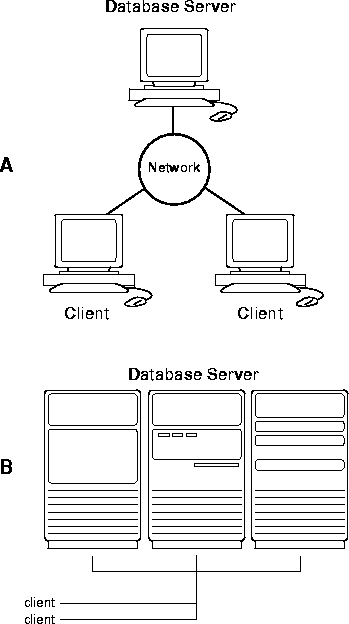Release 8.0
A58227-01
Library |
Product |
Contents |
Index |
| Oracle8 Concepts Release 8.0 A58227-01 |
|
We must try to trust one another. Stay and cooperate.
Jomo Kenyatta
This chapter defines distributed processing and describes how the Oracle server and database applications work in a distributed processing environment. This material applies to almost every type of Oracle database system environment.
This chapter includes:
In the Oracle database system environment, the database application and the database are separated into two parts: a front-end or client portion, and a back-end or server portion - hence the term client/server architecture. The client executes the database application that accesses database information and interacts with a user through the keyboard, screen, and pointing device such as a mouse. The server executes the Oracle software and handles the functions required for concurrent, shared data access to an Oracle database.
Although the client application and Oracle can be executed on the same computer, greater efficiency can often be achieved when the client portion(s) and server portion are executed by different computers connected via a network. The following sections discuss possible variations in the Oracle client/server architecture.
Distributed processing is the use of more than one processor to perform the processing for an individual task. Examples of distributed processing in Oracle database systems appear in Figure 29-1.
|
Note: This chapter applies to environments with one database on one server. In a distributed database, one server (Oracle) may need to access a database on another server. See Chapter 30, "Distributed Databases", for more information about clients and servers in distributed databases. |

In the networked example (Part A), the server and clients communicate via Net8, Oracle's network interface. See "Net8" on page 29-5 for more information.
Oracle client/server architecture in a distributed processing environment provides the following benefits:
Net8 is the Oracle network interface that allows Oracle tools running on network workstations and servers to access, modify, share, and store data on other servers. Net8 is considered part of the program interface in network communications. See Chapter 7, "Process Structure", for more information about the program interface.
Net8 uses the communication protocols or application programmatic interfaces (APIs) supported by a wide range of networks to provide a distributed database and distributed processing for Oracle.
Communication protocols define the way that data is transmitted and received on a network. In a networked environment, an Oracle server communicates with client workstations and other Oracle servers using Net8. Net8 supports communications on all major network protocols, ranging from those supported by PC LANs to those used by the largest mainframe computer systems.
Without the use of Net8, an application developer must manually code all communications in an application that operates in a networked distributed processing environment. If the network hardware, topology, or protocol changes, the application has to be modified accordingly.
However, by using Net8, the application developer does not have to be concerned with supporting network communications in a database application. If the underlying protocol changes, the database administrator makes some minor changes, while the application requires no modifications and will continue to function.
Net8 drivers provide an interface between Oracle processes running on the database server and the user processes of Oracle tools running on other computers of the network.
The Net8 drivers take SQL statements from the interface of the Oracle tools and package them for transmission to Oracle via one of the supported industry-standard higher level protocols or programmatic interfaces. The drivers also take replies from Oracle and package them for transmission to the tools via the same higher level communications mechanism. This is all done independently of the network operating system.
|
Additional Information:
Depending on the operating system that executes Oracle, the Net8 software of the database server may include the driver software and start an additional Oracle background process; see your Oracle operating system-specific documentation for details. Refer to the Oracle Net8 Administrator's Guide for additional information on Net8. |